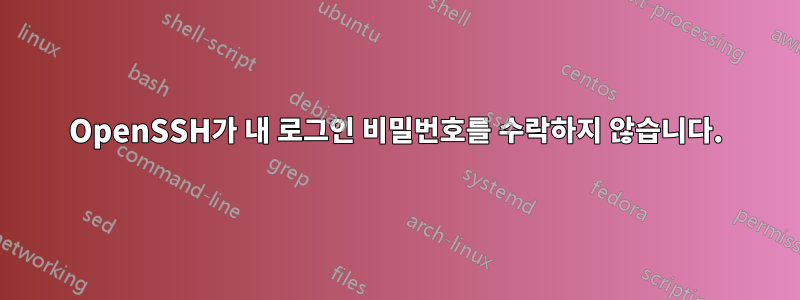
Windows 10 선택적 기능 섹션을 통해 실행되는 OpenSSH 서버 및 클라이언트를 성공적으로 설정했습니다.
서버에 로그인하려고 할 때마다 비밀번호를 묻는 메시지가 나타납니다. 저는 Windows 10 PC에 비밀번호를 하나만 구성했는데, 이것이 바로 제 Microsoft 계정의 비밀번호입니다. 그러나 서버는 해당 비밀번호로 접근을 거부합니다. 아직 SSH 서버에 대한 비밀번호를 설정하지 않았습니다.
서버의 기본 비밀번호는 무엇입니까?
폴더 sshd_config에 있는 파일 의 내용은 다음과 같습니다 .%PROGRAMDATA%\ssh\
# This is the sshd server system-wide configuration file. See
# sshd_config(5) for more information.
# The strategy used for options in the default sshd_config shipped with
# OpenSSH is to specify options with their default value where
# possible, but leave them commented. Uncommented options override the
# default value.
#Port 22
#AddressFamily any
#ListenAddress 0.0.0.0
#ListenAddress ::
#HostKey __PROGRAMDATA__/ssh/ssh_host_rsa_key
#HostKey __PROGRAMDATA__/ssh/ssh_host_dsa_key
#HostKey __PROGRAMDATA__/ssh/ssh_host_ecdsa_key
#HostKey __PROGRAMDATA__/ssh/ssh_host_ed25519_key
# Ciphers and keying
#RekeyLimit default none
# Logging
#SyslogFacility AUTH
#LogLevel INFO
# Authentication:
#LoginGraceTime 2m
#PermitRootLogin prohibit-password
#StrictModes yes
#MaxAuthTries 6
#MaxSessions 10
#PubkeyAuthentication yes
# The default is to check both .ssh/authorized_keys and .ssh/authorized_keys2
# but this is overridden so installations will only check .ssh/authorized_keys
AuthorizedKeysFile .ssh/authorized_keys
#AuthorizedPrincipalsFile none
# For this to work you will also need host keys in %programData%/ssh/ssh_known_hosts
#HostbasedAuthentication no
# Change to yes if you don't trust ~/.ssh/known_hosts for
# HostbasedAuthentication
#IgnoreUserKnownHosts no
# Don't read the user's ~/.rhosts and ~/.shosts files
#IgnoreRhosts yes
# To disable tunneled clear text passwords, change to no here!
#PasswordAuthentication yes
#PermitEmptyPasswords no
#AllowAgentForwarding yes
#AllowTcpForwarding yes
#GatewayPorts no
#PermitTTY yes
#PrintMotd yes
#PrintLastLog yes
#TCPKeepAlive yes
#UseLogin no
#PermitUserEnvironment no
#ClientAliveInterval 0
#ClientAliveCountMax 3
#UseDNS no
#PidFile /var/run/sshd.pid
#MaxStartups 10:30:100
#PermitTunnel no
#ChrootDirectory none
#VersionAddendum none
# no default banner path
#Banner none
# override default of no subsystems
Subsystem sftp sftp-server.exe
# Example of overriding settings on a per-user basis
#Match User anoncvs
# AllowTcpForwarding no
# PermitTTY no
# ForceCommand cvs server
이것은 다음의 출력입니다 Get-NetFirewallRule -Name *ssh*.
Name : OpenSSH-Server-In-TCP
DisplayName : OpenSSH SSH Server (sshd)
Description : Inbound rule for OpenSSH SSH Server (sshd)
DisplayGroup : OpenSSH Server
Group : OpenSSH Server
Enabled : True
Profile : Any
Platform : {}
Direction : Inbound
Action : Allow
EdgeTraversalPolicy : Block
LooseSourceMapping : False
LocalOnlyMapping : False
Owner :
PrimaryStatus : OK
Status : The rule was parsed successfully from the store. (65536)
EnforcementStatus : NotApplicable
PolicyStoreSource : PersistentStore
PolicyStoreSourceType : Local
Name : SshProxy-Service
DisplayName : SshProxy-Service-Private
Description : SSH Server Proxy Service
DisplayGroup : Ssh Server
Group : Ssh Server
Enabled : True
Profile : Private
Platform : {}
Direction : Inbound
Action : Allow
EdgeTraversalPolicy : Block
LooseSourceMapping : False
LocalOnlyMapping : False
Owner :
PrimaryStatus : OK
Status : The rule was parsed successfully from the store. (65536)
EnforcementStatus : NotApplicable
PolicyStoreSource : PersistentStore
PolicyStoreSourceType : Local
Name : SshProxy-Service-Domain
DisplayName : SshProxy-Service-Domain
Description : SSH Server Proxy Service
DisplayGroup : Ssh Server
Group : Ssh Server
Enabled : True
Profile : Domain
Platform : {}
Direction : Inbound
Action : Allow
EdgeTraversalPolicy : Block
LooseSourceMapping : False
LocalOnlyMapping : False
Owner :
PrimaryStatus : OK
Status : The rule was parsed successfully from the store. (65536)
EnforcementStatus : NotApplicable
PolicyStoreSource : PersistentStore
PolicyStoreSourceType : Local
출력 [System.Security.Principal.WindowsIdentity]::GetCurrent().Name:
<my_name>\USER
답변1
아직 SSH 서버에 대한 비밀번호를 설정하지 않았습니다. 서버의 기본 비밀번호는 무엇입니까?
하나도 없습니다.
서버에 로그인하려고 할 때마다 비밀번호를 묻는 메시지가 나타납니다. 저는 Windows 10 PC에 비밀번호를 하나만 구성했는데, 이것이 바로 제 Microsoft 계정의 비밀번호입니다. 그러나 서버는 해당 비밀번호로 접근을 거부합니다.
잘못된 사용자 이름으로 연결을 시도하고 있습니다. ssh Machine_Name\Username@localhost서버에 연결하려면 사용해야 합니다 .
왜 \USER 부분을 제공해야 합니까?
OpenSSH 서버에 연결하려면 사용하려는 사용자 이름을 명시적으로 지정해야 합니다. 또한 ssh <my_name>@localhost사용자 이름이 실제 사용자 이름이 아닌 컴퓨터 이름임을 나타내는 구문을 사용했다고 표시했습니다 .
부터<my_name>은(는) 컴퓨터의 실제 사용자 이름이 아닙니다. 비밀번호 인증에 실패했습니다. 실제로 사용해야 합니다.Username그리고 그것이 컴퓨터에 있다는 것을 명시적으로 나타냅니다.Machine_Name\Username.
의 출력은 [System.Security.Principal.WindowsIdentity]::GetCurrent().Name무엇을 사용해야 하는지를 나타냅니다.
답변2
유효한 사용자 이름과 비밀번호를 허용하지 않는 또 다른 이유는 구성된 셸이 잘못된 경우입니다.
어떤 것인지 확인할 수 있습니다
reg query HKLM\SOFTWARE\OpenSSH /v DefaultShell
기본 디렉터리에 Powershell이 있는 경우 이를 Powershell로 설정하려면 다음을 수행하세요.
reg add HKLM\SOFTWARE\OpenSSH /v DefaultShell /d C:\Windows\system32\WindowsPowerShell\v1.0\powershell.exe
답변3
whoamicmd에 작성 하면 텍스트가 제공되고 전체 텍스트를 복사합니다. 전체는 전체를 의미합니다. 이 예에서는 내가nick\hp출력을 얻었다고 가정해 보겠습니다 .이제 cmd에 를 입력
ssh nick\hp@localhost하고 Enter를 누르세요.비밀번호를 묻는 메시지가 나타나면 여기에 Microsoft 계정의 비밀번호를 입력하세요. 그리고 당신은 성공적으로 SSH에 접속할 것입니다.
답변4
비슷한 문제가있었습니다. ssh 로그인은 어느 날까지 정상적으로 작동했습니다. 정확히 무슨 일이 일어났는지 잘 모르겠습니다. 삼바를 통해 Windows 폴더를 공유하려고 시도하여 일부 openssh 설정을 망쳤을 수도 있습니다. 어쨌든 해결책은 다음과 같습니다.
새로운 Windows 사용자 생성
그게 다야. 새 계정으로 정상적으로 로그인할 수 있습니다. 내가 아무것도 하지 않은 채 이전 계정의 SSH 비밀번호가 변경된 것 같습니다.


